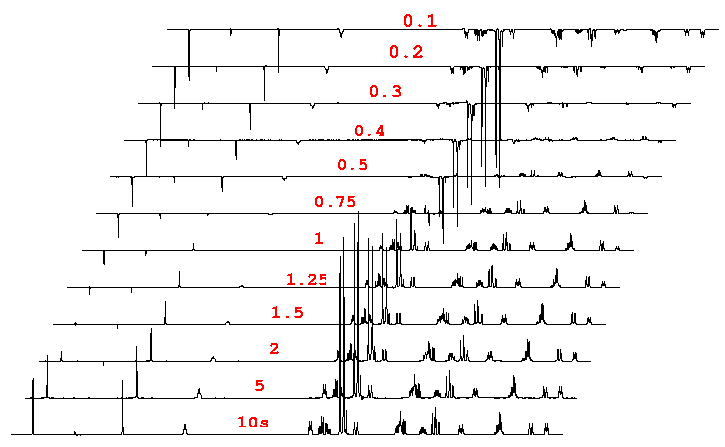|
|
The inversion-recovery experiment allows to measure longitudinal or spin-lattice T1 relaxation times of any nucleus.REQUIREMENTS
Easy implementation on AVANCE spectrometers.VERSIONS
The basic pulse sequence of the inversion-recovery experiment consists of the following steps:EXPERIMENTAL DETAILSThis procedure can be used to measure T1 relaxation times of any nucleus. For instance, in the case of 13C, all pulses and acquisition are applied on 13C channel while broadband proton decoupling is applied during all sequence. A complete revision work about methods to measure T1 relaxation times has been appeared in 99CONC243
- A 180º pulse inverts the magnetization to the -z axis.
- During the following delay t, relaxation along the longitudinal plane takes place. Magnetization come back to the original equilibrium z-magnetization.
- A read 90º pulse creates transverse magnetization
- Acquisition is performed as usual
The Inversion-recovery experiment can be acquired, processed and plotted in a fully automated way. Minor changes from a predefined parameter set are required. Important parameters to consider are:SPECTRA
- Relaxation delay must be set to 5*T1
- The experiment is repeated for a series of delays values.
- Rough estimation of the T1 value from the null-point value by using T1=tnull/ln(2). Quantitative analysis can be performed using the relaxation T1 /T2 software.
For further details on practical implementation of the inversion-recovery experiment on AVANCE spectrometers see:
The inversion-recovery experiment affords conventional 1D spectra. The signal intensities will shown a dependence with the interpulse t delay value:RELATED TOPICS
- Using a short delay, all signals will shown negative intensities (aligned to -z axis)
- The intensity of the signals will decrease (will be less negative) when the delay is increased
- The null-point (tnull) is achieved when the corresponding signal is missing (intensity zero)
- Using longer delays, the signal intensities become positive.

See T1 Spectra
Related selective inversion-recovery experiments are efficient methods of measuring proton spin-lattice cross-relaxation rates in crowded regions ( 92MRC173 , 92JACS5412 , 93JB335 )